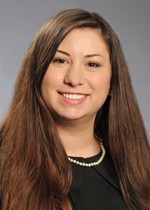2015 Young Investigator: Kathleen Cicero

Nominee:
Nominated By:
Supporting Comments:
What made you choose a career in bioanalysis?
I have always had an interest in analytical sciences. After college I was given an opportunity to work in the LC-MS/MS and GC-MS/MS fields and bioanalysis started to grow on me. I loved the problem solving and challenges each new molecule posed. After working to develop methods with LC- and GC-MS for more than 5 years I moved into the analysis of larger molecules and ELISA based assays. New techniques, instrumentation, and a new set of problems to solve was a very exciting challenge!
Describe the main highlights of your bioanalytical research, and its importance to the bioanalytical community.
Working for a bioanalytical Contract Research Organization (CRO) is often fast-paced, and leaves little time to explore novel topics. As a result of this fast-paced environment we must develop robust and rugged methods that focus on efficiency while keeping production costs low. Adapting new technologies to improve throughput allows for our company to keep sample prices low and reduce the time it takes for analysis. Our clients can receive their results faster and their biological products can be submitted for approval sooner. The ultimate goal is to reduce the time it takes for new treatment options and medications to become available to patients.
Describe the most difficult challenge you have encountered in the laboratory and how you overcame it.
Coming from an LC-MS/MS background, I was only used to screening matrix for endogenous analytes. The only requirement for the individual lots was that they yielded a response below the lower limit of quantitation. For ligand binding assays this approach may not be enough or appropriate. In one assay I was developing, only 40% of the lots yielded responses below quantitation due to matrix effects. Creating a pool from only these 4 lots lead to problems after assay validation as it became difficult to replicate the original pools response. Long term stability had to be restarted since the original pool was not representative of the population. In another case, an IFN-alpha assay, only screening matrix lots to ensure the pool was below quantitation lead to an investigation when no response from the QC was observed after preparing the QC batch from this pool. To trouble shoot, I rescreened each lot at the low and high QC levels. What I found was that one matrix lot was causing the signal suppression, but a few other lots I noticed also showed some variability. I was eventually able to bridge the QC batches by preparing a pool with a similar response as the previous pool.
Where do you see your career in bioanalysis taking you?
It’s difficult to say where I might find myself in several years. Opportunities can happen at a moment’s notice. Six years ago I would not have thought I would have been given the opportunity to move to the ligand binding group, but situations change and we adapt. I love where I am now, and my job is never boring and presents me with challenges daily. Process improvement, mentoring, and exploring new techniques is where I hope my career continues to take me.
How do you envisage the field of bioanalysis evolving in the future?
New drug classes such as antidrug conjugates will require better collaborations between mass spectrometrists, chromatographers, and ligand binding groups to ensure patient safety and accurate analysis of pharmacokinetic responses.
Bioanalysis evolves because its force to keep up with the new drug types developed. I believe treatment options will move towards individually designed regiments based on a patients own genetic profile. This tailored approach would need extensive characterization of the drug products and individuals alike. Maybe the clients of the future will not be just Pharmaceutical companies but actual patients looking to find the best treatments for their specific needs and body.
Please list up to five of your publications in the field of bioanalysis:
1. Poster: V. Chellaraj, K. Cicero, C. Beaver, et al. Comparison Between Two UV ELISA Kits and an Electrochemiluminescence ELISA Method for the Quantification of HUMIRA® (Adalimumab) in Human Serum. AAPS National Biotech Conference, San Diego, May 2013.
2. Poster: J. Hantash, K. Cicero, L. Lundberg, S. Gadkari, H. Desai, G. Scott and C. Beaver Validation of methods for the determination of low molecular heparin anti-IIa activity assays for analysis of Enoxaparin. AAPS National Biotech Conference, San Diego, May 2013.
3. Poster: J. Hantash, K. Cicero, L. Lundberg, S. Gadkari, H. Desai, G. Scott and C. Beaver Validation of methods for the determination of low molecular heparin anti-Xa activity assays for analysis of Enoxaparin. AAPS National Biotech Conference, San Diego, May 2013.
4. Poster: K. L. Cicero, M. E. Vargek, R. M. LeLacheur. Quantitation of Citrulline, a highly polar amino acid and potential biomarker, using mixed-mode ion exchange chromatography with MS/MS detection. American Society for Mass Spectrometry Proceedings, Indianapolis, June 2007
Please select one publication from above that best highlights your career to date in the field of bioanalysis and provide an explanation for your choice.
So much of my current career path has revolved around biosimilars. Low molecular weight heparin (LMWH) was the first validation that I worked on for biosimilar analysis. I was able to automate the anti-Xa assay and increase through put to 180 samples per day with only one person. The increased throughput allowed for our group to achieve the client’s timelines even with limited resources during the holidays.




